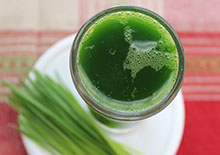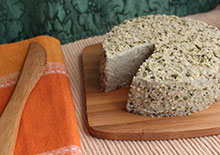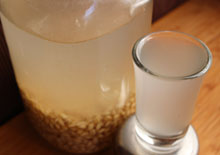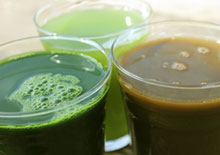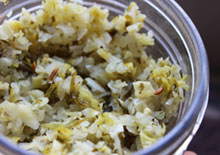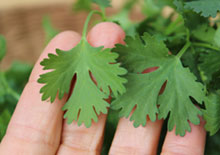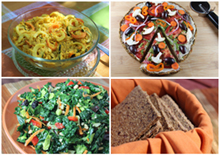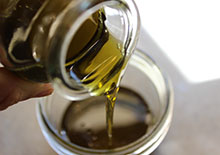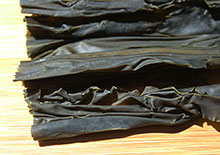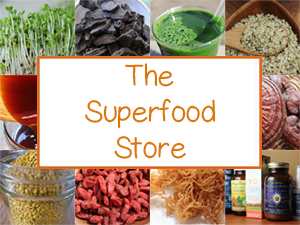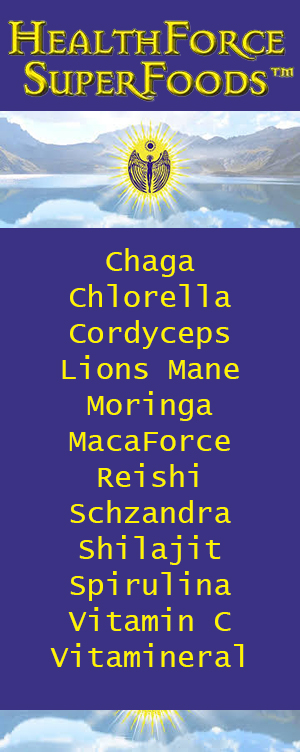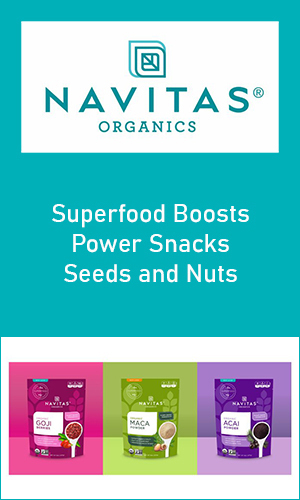Raw Soup Recipes, Blended Enzyme-Rich Energy Soups

Raw soup recipes are a delicious and nutritious "fast food." They are not only simple to prepare, but are also extremely easy to digest and immediately utilized as an energizing food.
This is one of the reasons why the late great Dr. Ann Wigmore called them "raw energy soups." Dr. Wigmore essentially used these soups, along with wheatgrass and vegetable juices, for treating her patients overcome with serious life-threatening illnesses. Her basic rendition included leafy greens, sprouts, avocado, apple, seaweeds and rejuvelac.
Today there are many other variations using different types of fats and an assortment of vegetables and spices. Over the years we have come up with a few of our own favorites, three of which we share below.
From a nutritional stand-point, the fundamental ideal behind these soups is to essentially blend up your unheated ingredients so that they are predigested and therefore easier to assimilate.
Because they are composed of raw living plant-based foods, they are additionally rich in food enzymes which are naturally present in fruits, vegetables, nuts, seeds and cultured foods that have not been heated over 115–118° F (45-48°C). These are vital elements to health and digestion well-known by those who follow a raw vegan diet.
Foods rich in enzyme content are believed to help preserve our own metabolic and digestive enzymes, which become depleted as we age or when the diet is compromised by an over-abundance of processed, fatty-rich, preserved, cooked and refined foods.
These flavorful purées are also full of fiber content and very hydrating to the body, perfect for sluggish digestion and constipated conditions.
Blended raw soup recipes are therefore highly recommended when digestion is off track or you're feeling fatigued, stressed or on the verge of sickness.
These types of soups can basically be made with any leftover veggies in your fridge or can be created from freshly picked garden produce or farmers market selections. The more vibrant and fresh... the better for overall health benefits.
If you're not someone who likes to juice fast, soups can be a nice alternative when taking a break from cooked meals. Depending on the ingredients incorporated, they can supply an ample amount of vitamins and minerals helpful for fortifying depleted states and can be cleansing meals to consume for certain health issues and autoimmune disorders.
Raw Soup Recipe Tips
Creating a Good Texture - Mouth-feel is an important thing to consider when making your raw soup recipes. A straight blend of raw veggies and spices might taste more like a spiced smoothie than a savory soup. It is much more appealing to the palette to add different textural elements as toppings or non-blended add ins. This may include spiralized zucchini pasta, seaweed noodle strips, or a few thinly sliced vegetables or toppings that add a crunch or a pickled taste. Other options could also include dehydrated croutons, chopped nuts or seeds, sprouts, seed cheese or sauerkraut. These added items will also help you to "chew your soup" which will further encourage maximum digestive absorption and nutritional benefits.
Using Herbal Teas - Nutritive herbal teas are great to use as a base broth liquid instead of water. While they are not exactly considered a "raw" liquid, tea infusions are one of the best ways to consume certain herbs that are not normally as edible to humans. These are teas created from herbs like nettle, oatstraw, red clover or horsetail. They can be made ahead of time and stored in the fridge for use when you're ready to blend your soup ingredients. Likewise, other herbal tea formulations can also be incorporated utilizing many of the Ayurvedic and Chinese tonic herbs.
Adding Rejuvelac - The original version of Ann Wigmore's energy soup employed the use of the fermented grain beverage, rejuvelac. This will add a probiotic element and will also increase enzyme content. While original recipes are made using wheatberries, gluten-free options are also possible using grains like quinoa.
High Speed Blending - It is a worthwhile investment to purchase a high speed blending device, especially if you've decided to consume raw soups on a frequent basis. These machines are very durable for everyday use and have no problem completely blending dense food items. In addition, they are very versatile for use when making a number of drinks, desserts and vegan cheeses that require a creamy smooth texture. High speed blenders are also very useful appliances for powdering tough rooty herbs or culinary spices like peppercorns or cinnamon sticks.
Green Leafy Vegetables - Like green smoothies, raw soups are a great way to consume more leafy green vegetables without having to munch down on large bowls of salad or eat steamed greens, like kale, collard, spinach or parsley. For those who don't prefer the taste, they are easily camouflaged when used in combination with savory herbs, tangy flavors and creamy fats. Raw energy soups are moreover the perfect opportunity to use wild greens that are sometimes less palatable to the taste buds. When available, they can be used in replacement for cultivated varieties in any recipe.
Superfood Supplementation - Raw soups are a great way to get nutritious seaweeds and/or other superfoods into your diet. Any blended soup or beverage is a chance to utilize many of the powdered medicinal mushroom extracts as well as tonic herbs and even superfruits like goji berry.
Raw Soup Recipes
Here are our top three favorite raw soup recipes to get you started on your blended soup making adventures.
When making a nutritive herbal tea as the base liquid, you can use 2-3T of herbs infused in 2C hot water for 15 minutes or longer.
These recipes are designed to make approximately 1-1 ½ quart of soup or between 4-6 cup servings.
Raw Cream of Pea Soup

Ingredients
- 1C nutritive herbal tea
- 1C almond milk
- 1C peas (fresh or frozen)
- 1C chopped cauliflower
- 1C chopped parsley
- 1C chopped green onion
- 1/2C grated green apple
- 1/2C hemp seeds
- 2T hemp oil
- 2T lucuma powder
- 1/2t garlic powder
- 1/4t stevia
- 1/4t celery seeds
- 1/4t sea salt or pink salt
- 1/4t pepper
Directions:
- Place all ingredients in a high speed blender.
- Blend until creamy smooth.
Top with sauerkraut, seed cheese, hemp seeds, green onion or pea shoots and steamed shiitake mushroom.
Raw Coconut Curry Soup
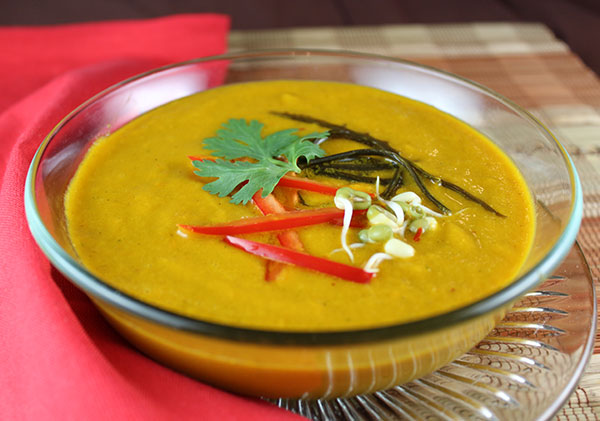
Ingredients:
- 1C nettle and lemon grass tea
- 1C coconut water (from Thai coconut)
- 1C chopped carrots
- 1C Thai coconut meat
- 3/4C chopped celery
- 3/4C chopped cucumber
- 1/2C chopped yellow bell pepper
- 2 medjool dates
- 2T lime juice
- 2t curry powder
- 2t miso paste
- 1t grated ginger root
- 1/4t turmeric powder
- 1/4t Thai chili flakes
- 1/4t stevia
- 1/4t sea salt or pink salt
Directions:
- Place all ingredients in a high speed blender.
- Blend until creamy smooth.
Top with thinly sliced red bell pepper, cilantro, seaweed strips and mung bean sprouts.
Raw Vegetable Soup
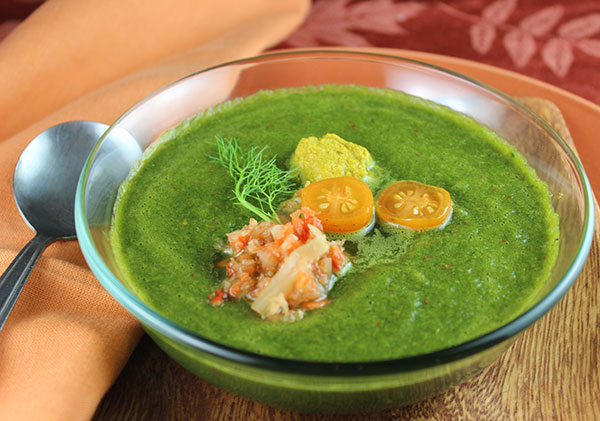
Ingredients:
- 2C nutritive herbal tea
- 1C lacinato kale
- 1C broccoli florets
- 1/2C chopped fennel bulb
- 1/2C chopped cucumber
- 1/2C chopped zucchini or yellow squash
- 1/2C chopped bell pepper
- 1/2 an avocado
- 8 yellow cherry tomatoes
- 1/4C chopped celery
- 1/2 clove of garlic
- 2t miso
- 1t kelp powder
- 2t Italian spices
- 1/4t sea salt or pink salt
- 1/4t black pepper
Directions:
- Place all ingredients in a high speed blender.
- Blend until creamy smooth.
Top with kimchi, seed cheese, yellow tomato and fennel sprigs.
Try some of our other condiments that go well with raw soup recipes.
